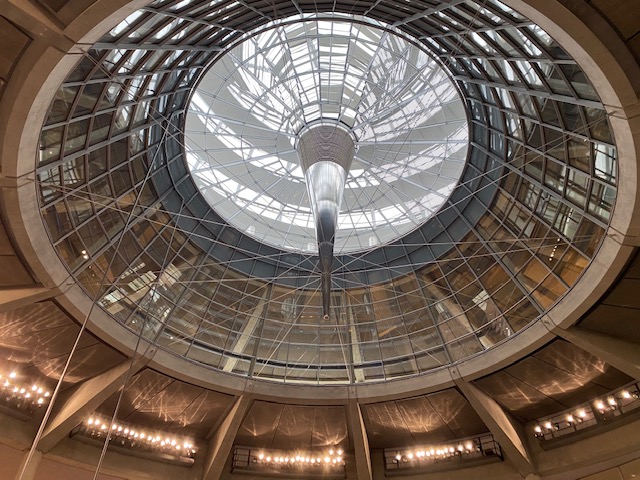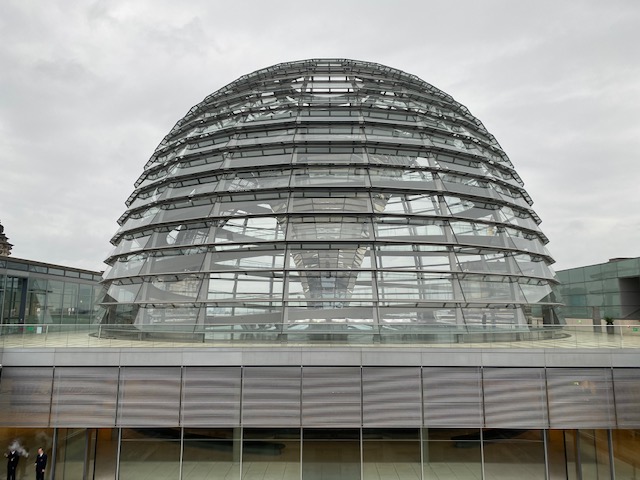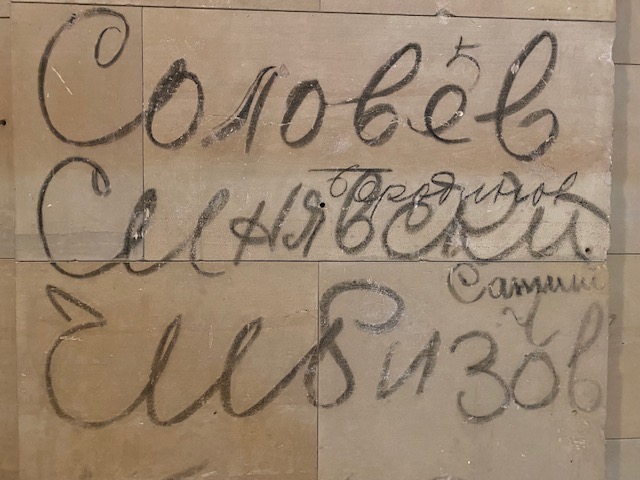
Autumn 2021. In theory we could travel to other continents, but destinations we had in mind such as Japan or the United Kingdom were impossible to plan ahead. Instead we organised a rail trip to Eastern Europe, travelling to Berlin, Gdańsk, Wrocław, Karlovy Vary, Pilsen, Bratislava, Poprad, Vienna, Linz and Salzburg. By travelling to Germany, Poland, Czechia, Slovakia and Austria, we explore an area which was in the (not too distant) past bonded together by the Holy Roman Empire of the German Nation and by Austria-Hungary.
Day 2 in Berlin was a busy day. After the Pergamon Panorama, a walk to Alexanderplatz, the Red City Hall (Rotes Rathaus) and Brandenburg Gate, and after a visit to the Humboldt Forum, we visited the Bundestag in the Reichstag.
Reichstag is nowadays the name of the building. Bundestag is the name of the federal lower house of Germany. It’s the federation’s House of Commons or House of Representatives if you will.
The Reichstag was constructed to house the Imperial Diet – in German: Reichstag – of the German Empire. It was opened in 1894 and housed the Diet until 1933, when it was severely damaged after being set on fire. After World War II, the building fell into disuse.
The parliament of the German Democratic Republic (GDR), the Volkskammer, met in the Palast der Republik in East Berlin, while the parliament of the Federal Republic of Germany (FRG), the Bundestag, met in the Bundeshaus in Bonn.

Troubled past
The building has a troubled past.
Construction of the building began well after the unification of Germany in 1871. Previously, the parliament had assembled in several other buildings in Leipziger Straße in Berlin but these were generally considered too small. So, in 1872 an architectural contest with 103 participating architects was carried out to erect a new building. After a short survey of possible sites, a parliamentary committee recommended the east side of the Königsplatz (today, Platz der Republik), which was occupied by the palace of a Polish-Prussian aristocrat, Athanasius Raczyński.
But Wilhelm I, Otto von Bismarck and the members of the Reichstag argued much so construction didn’t start. After lengthy negotiations, the Raczyński Palace was purchased and demolished, making way for the new building.
A new contest was held, won by Paul Wallot from Frankfurt. The direct model for Wallot’s design was Philadelphia‘s Memorial Hall, the main building of the 1876 Centennial Exhibition.
Wallot adorned the building’s façade with crowns and eagles symbolising imperial strength. The building’s four corner towers represented the four German kingdoms at unification, Prussia, Bavaria, Saxony and Württemberg, and the heraldic coat of arms of each kingdom, as well as smaller devices representing various German city-states, flanked the main entrance, celebrating the process of unification.
Construction started in 1884 and was completed in 1894.
In 1916 the iconic words “Dem Deutschen Volke” (“To the German People”) were placed above the main façade of the building.
The building continued to be the seat of the parliament of the Weimar Republic (1919–1933), which was still called the Reichstag. Up to 42 protesters died during the Reichstag Bloodbath of 13 January 1920, when workers tried to protest a law that would restrict their rights, it was the bloodiest demonstration in German history.

1933
The building caught fire on 27 February 1933, under circumstances still not entirely known. This gave a pretext for the NSDAP to suspend most rights provided for by the 1919 Weimar Constitution in the Reichstag Fire Decree, allowing them to arrest Communists and other enemies, and increase police action throughout Germany.
During the 12 years of NS rule, the Reichstag building was not used for parliamentary sessions. Instead, the few times that the Reichstag convened at all, it did so in the Kroll Opera House, opposite the Reichstag building. This applied particularly to the session of 22 March 1934, in which the Reichstag surrendered its powers to Adolf Hitler in the Enabling Act, another step in the so-called Gleichschaltung (“coordination”). The main meeting hall of the building (which was unusable after the fire) was instead used for propaganda presentations and, during World War II, for military purposes. It was also considered for conversion to a flak tower but was found to be structurally unsuitable.
The NS rulers weren’t interested in restoring the parliament. It used it as an excuse for emergency powers which never conceded.
The building, never fully repaired after the fire, was further damaged by air raids. During the Battle of Berlin in 1945, it became one of the central targets for the Red Army to capture, due to its perceived symbolic significance.

Cold War
When the Cold War emerged, the building was physically within West Berlin lying in the British zone, but only a few metres from the border of East Berlin, which ran around the back of the building and in 1961 was closed by the Berlin Wall.
After the war, the building was essentially a ruin. In addition, there was no real use for it, since the seat of government of West Germany had been established in Bonn in 1949.
Still, in 1956, after some debate, the West German government decided that the Reichstag should not be torn down, but be restored instead. However, the cupola of the original building, which had also been heavily damaged in the war, was demolished.
Another architectural contest was held, and the winner, Paul Baumgarten, reconstructed the building from 1961 to 1964. He removed all sumptuous heraldic statues, monuments, decorations, and the like that harked back to the mythology of the German past from the inside, and also the largest ones on the outside of the building. In effect, he created a plain building inside the historic Reichstag, retaining only the outer walls stripped of most of their statues and decoration.
The artistic and practical value of his work was the subject of much debate after German reunification.
Under the 1971 Four Power Agreement on Berlin, Berlin was formally outside the bounds of either East or West Germany, and so the West German parliament, the Bundestag, was not allowed to assemble formally in West Berlin. This prohibition was obeyed even though East Germany had declared East Berlin its capital, violating this provision.
Until 1990, the building was thus used only for occasional representative meetings, and one-off events.

After Reunification
The official German reunification ceremony on 3 October 1990, was held at the Reichstag building, including chancellor Helmut Kohl, president Richard von Weizsäcker, former chancellor Willy Brandt and many others. The event included huge firework displays. The following day the parliament of the united Germany assembled as a symbolic act in the Reichstag building.
However, at that time, the role of Berlin had not yet been decided upon. Only after a fierce debate, considered by many as one of the most memorable sessions of parliament, on 20 June 1991, did the Bundestag conclude with quite a slim majority in favour of both government and parliament returning to Berlin from Bonn.
In 1992, Norman Foster won yet another architectural contest for the reconstruction of the building. His winning concept looked very different from what was later executed. Notably, the original design did not include a cupola.
Before reconstruction began, the Reichstag was wrapped by Christo and his wife Jeanne-Claude in 1995, attracting millions of visitors.
The project was financed by the artists through the sale of preparatory drawings and collages, as well as early works of the 1950s and 1960s.
During the reconstruction, the building was first almost completely gutted, taking out everything except the outer walls, including all changes made by Baumgarten in the 1960s.
Respect for the historic aspects of the building was one of the conditions stipulated to the architects, so traces of historical events were to be retained in a visible state.
Among them were graffiti left by Soviet soldiers after the final battle for Berlin in April–May 1945. Written in Cyrillic script, they include such slogans as “Hitler kaputt” and names of individual soldiers.
However, graffiti with racist or sexist themes were concealed, in agreement with Russian and Ukrainian diplomats at the time.
Reconstruction was completed in 1999, with the Bundestag convening there officially for the first time on 19 April of that year.
The tour
Our guide, who didn’t introduced himself with his name, was very knowledgeable. A former official at the European Union, a diplomat and a lawyer, he not only pointed us to the architectural history of the Reichstag, but also explained some intricacies of the present-day Bundestag workings. No electronic votes, for instance, the importance of mentioning ‘fraction’ when communicating as a parliamentarian from the Reichstag and other anecdotes.
So we saw the Soviet graffiti up close, went into the plenary chamber and visited the rooftop terrace with the dome. The dome itself was closed for maintenance.
The tour was absolutely interesting. As an enthusiast of palaces and parliaments, I thoroughly enjoyed the experience.




67 Comments Add yours